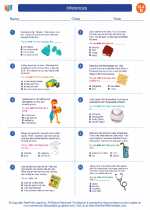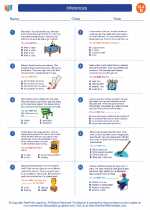Inferences
Inferring is the act of passing from one proposition, statement, or judgment considered as true to another whose truth is believed to follow from that of the former.
◂English Language Arts Worksheets and Study Guides Fourth Grade. Inferences
Activity Lesson Inferences
Inferences  Worksheet/Answer key
Worksheet/Answer key Inferences
Inferences  Worksheet/Answer key
Worksheet/Answer key Inferences
Inferences  Worksheet/Answer key
Worksheet/Answer key Inferences
Inferences 

 Worksheet/Answer key
Worksheet/Answer key
 Worksheet/Answer key
Worksheet/Answer key
 Worksheet/Answer key
Worksheet/Answer key

The resources above cover the following skills:
General Reading Processes
Students will use a variety of strategies to understand what they read (construct meaning).
Use strategies to prepare for reading (before reading)
Survey and preview the text by examining features such as the title, illustrations, photographs, charts, and graphs
Make predictions and ask questions about the text
Use strategies to make meaning from text (during reading)
Make, confirm, or adjust predictions
Use strategies to demonstrate understanding of the text (after reading)
Identify and explain what is not directly stated in the text by drawing inferences
Draw conclusions or make generalizations about the text
Confirm, refute, or make predictions and form new ideas
Comprehension of Informational Text
Develop comprehension skills by reading a variety of self-selected and assigned print and non-print informational texts, including electronic media
Read, use, and identify the characteristics of functional documents such as sets of directions, science investigations, atlases, posters, flyers, forms, instructional manuals, menus, pamphlets, rules, invitations, recipes, advertisements, other functional documents
Identify and use text features to facilitate understanding of informational texts
Use graphic aids such as illustrations and pictures, photographs, drawings, sketches, cartoons, maps (key, scale, legend, graphs, charts/tables, and diagrams, other graphic aids encountered in informational texts
Use informational aids such as introductions and overviews, materials lists, timelines, captions, glossed words, labels, numbered steps, bulleted lists, footnoted words, pronunciation key, transition words, boxed text
Determine important ideas and messages in informational texts
State and support main ideas and messages
Draw conclusions and inferences and make generalizations and predictions from text
Comprehension of Literary Text
Use text features to facilitate understanding of literary texts
Identify and explain how informational aids such as introductions and overviews, materials lists, timelines, captions, glossed words, labels, numbered steps, bulleted lists, footnoted words, pronunciation keys, transition words, end notes, works cited, other information aids encountered in informational texts contribute to meaning